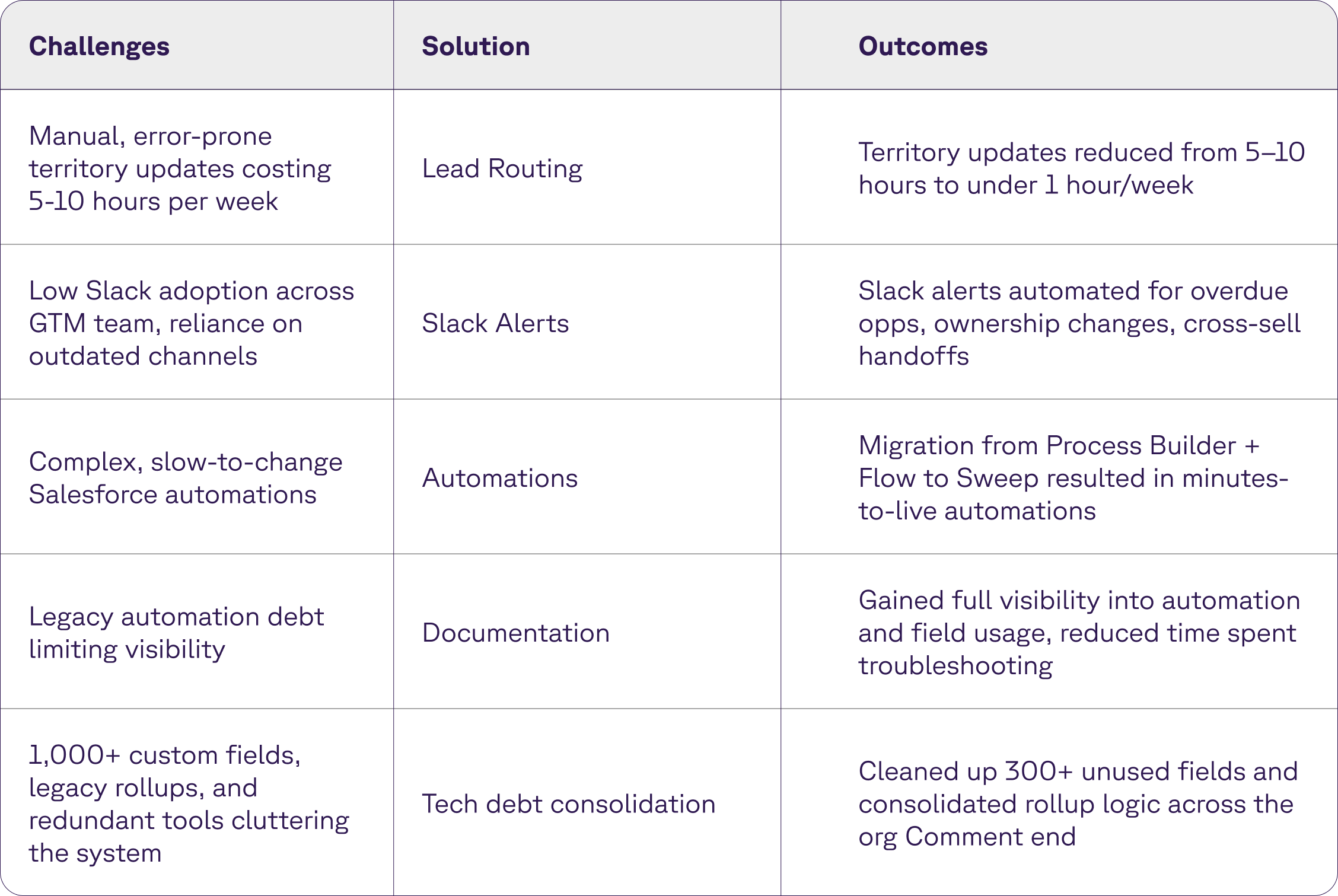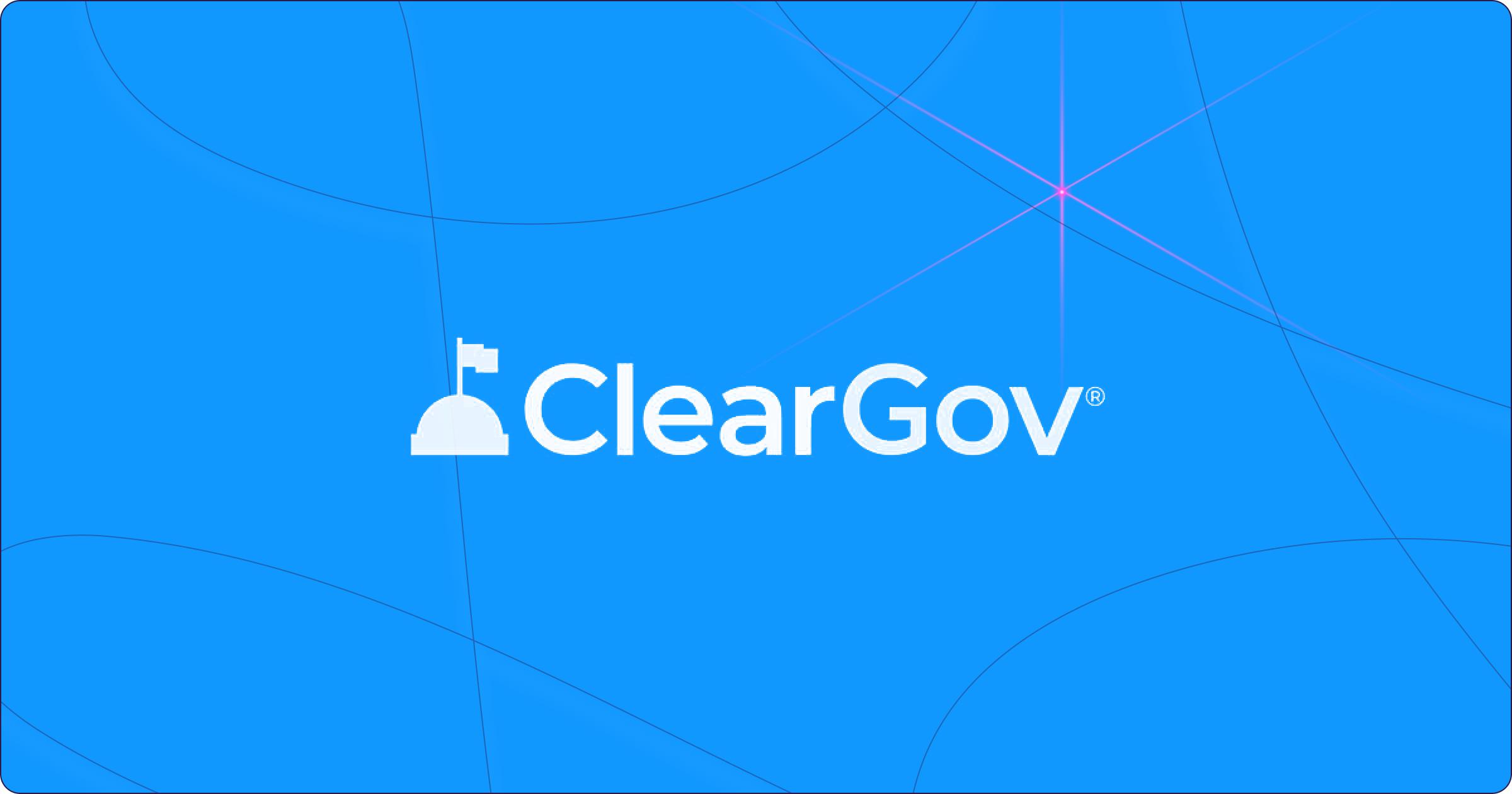In the world of sales operations, speed and clarity are the difference between a culture of winning and total irrelevance.
But when Kristin Fretz and Tzvi Gerstle joined ClearGov’s RevOps team, they stepped into a Salesforce org that had been somewhat… duct-taped together.
In Tzvi’s words, their GTM tech stack “worked on by multiple people in-house over multiple years… it was clearly a lot of patchwork.”
And these operational inefficiencies were holding their team back.
As a company, ClearGov helps local governments, counties, schools, and special districts plan, build, and present their budgets with confidence. Their software streamlines public sector budgeting by making it fast, accurate, and transparent, so communities can spend less time wrestling with process and more time focused on the strategic initiatives that help them thrive.

The buying journey: From lead routing to RevOps transformation
Despite these challenges, Kristin explained how the evaluation started narrowly, with a focus on routing inefficiencies: “We started the search looking for a lead routing tool, because it took us hours. What we found is that some vendors, like LeanData, have a really expensive lead routing solution. … What surprised us was that for a similar cost, Sweep offers 10x the number of features. And it wasn’t just about lead routing, it was about overriding what Salesforce doesn’t let you do. Duplicate rules have limits in Salesforce, lead routing, how you build automations, integrating Slack Alerts.”
For Tzvi, the platform’s versatility made the ROI conversation with leadership straightforward. “Being able to show a product that was so much more capable — it could do everything we needed in terms of territories — but also make our day-to-day lives more efficient as we’re managing the Salesforce product… it was a lot easier to show where the ROI was to leadership.”
ClearGov partnered with Sweep to execute a 60-day onboarding roadmap aimed at automating workflows, reducing technical debt, and modernizing their Salesforce stack. But as they got started, Kristin and Tzvi realized they could move even faster. They completed their entire rollout, plus stretch goals, in just 30 days.
Territory management and Lead Routing
The first priority was eliminating the hours of manual work involved in territory updates.
“We were spending on average 5 to 10 hours a week,” Tzvi said. “Between marking up all the spreadsheets, pulling the data, updating them in excel, running the updates could take hours, and then you’d have to go through and look at all of the related objects. If we were transferring accounts, we’d have to make sure the opportunities were changed, the task ownership was changed, because that doesn't happen when you’d do it through data loader…. It was a very time-consuming process and very error prone."
With Sweep in place, those hours vanished. “[Territory management] that’s something that’s been reduced now to maybe an hour a week, even less. Whenever we had a personnel change, it was, ‘This derails my whole week.’ Now it’s, ‘Let me get this done between some tasks and move on with my day,’” said Tzvi.
ClearGov also tackled long-deferred routing improvements.
Kristin said, “Once we figured out Sweep could date stamp when a marketing lead came in, how long it’s been in that status, we built a really robust contact automation workflow to help with the SLA tracking and where in our buyers journey are the leads. We built and tested it over the course of 30 days, and rolled it out to the team in two weeks. We were able to demystify this big concept of lead routing, some people could spend a year trying to perfect the plan. When things worked well, or didn’t, Sweep allows you to make changes quickly and deploy, with no delay.”
Automations and engineering lift
As the team transitioned territory and routing logic into Sweep, they quickly identified other automation opportunities.
Tzvi explained how the shift helped them scale: “We have way more work than what a 2-person team can manage but we do a good job of it because we’re able to create automations, and do all things that Sweep provides us, much more quickly than we would be able to do natively, and get around a lot of the limitations Salesforce provides.”
One of the most immediate wins was moving away from legacy tools like Process Builder and Flow, and building complex automations like developing logic to validate client website URLs by detecting redirects and pushing clean URLs back into Salesforce, a process that previously would have required developer support.
For a team managing constant change, speed is essential. “I now am able to build in Sweep at the speed of a Salesforce developer, of which I am not.” Kristin said, “The speed is instead of days and weeks, it’s minutes and hours… which is definitely appreciated when we have so many things coming at us each week. Sweep takes the pressure out of ‘We need to build something in Salesforce, that’s gonna be a big project.’ That’s not how we approach things now,” Kristin said.
Sweep also helped bridge the gaps between other tools in their stack, which includes Gong, Slack, Marketo, and ChurnZero.
“All these tools have Salesforce integrations. But they all lack one thing you wish it could do. Some things you can only do with API calls, or a developer, or you have to custom build it… We’re really excited about Sweep’s webhook integrations, we love using Sweep to plug the gaps of the other tools,” Kristin said.
Slack Alerts and rep enablement
ClearGov’s investment in automation wasn’t just about backend operations; it made an immediate impact on the sales team’s day-to-day experience. The team used Sweep to introduce automated alerts for everything from stale opportunities and close dates to cross-sell handoff reminders and deals stuck in the same stage. The result was increased visibility and faster action, without forcing reps to dig into Salesforce reports.
“Slack integration is the most rep-facing improvement we’ve made,” Kristin said. “So when your territory gets changed, you get a Slack alert, when your opportunity is overdue, you can press a button in Slack to change the close date.”
This shift dramatically reduced the need for manual follow-ups. “We just rolled out Chili Piper, they had some gaps in their Slack integration and we just used Sweep to make up the difference. It’s been really great to tap Sweep when other integrations fall short in Salesforce,” Kristin said.
These alerts also encouraged better CRM hygiene, without relying on manager check-ins. As Kristin said, “When I first joined, before Sweep, Tzvi would ping the reps every month ‘Hey, these are the overdue opportunities, with the closed dates in the past.’ These are the low-hanging fruit, proactive notifications we can send someone in Slack.”
Documentation and troubleshooting transparency
As ClearGov accelerated its automation efforts, understanding and managing inherited architecture became essential. With Sweep’s documentation tools, the team was able to confidently untangle legacy systems and make informed changes without fear of breakage.
“We had legacy admins in our system. So we had to undo things that neither of us built. And that’s always challenging,” Kristin explained. “But now we leverage Sweep’s documentation search or the AI agent to ask ‘how does this automation work?’”
“Sweep documentation is a saving grace for us,” Kristin shared. “I like the holistic view I now have. As opposed to in Salesforce, you need to know where to go look, or you make changes and suffer the consequences of whatever broke afterwards. We saved a lot of time not having to troubleshoot after making a change.”
For example, when odd behavior cropped up in automated emails, Sweep helped them isolate the issue. After building an email automation, the post-sales team started receiving phantom emails that had no data in them.
“We didn't understand why they were triggering,” Kristin said. “We checked every nook and cranny in the back end of Salesforce, every email template. Eventually we asked Ben [our Customer Success] please help. He sent us a screenshare, how to find it in Sweep. We were able to go in, and deactivate the automation.”
Kristin summed it up: “I feel much more confident building automations in Sweep, because I feel like we have much more control over troubleshooting when things go wrong. That’s a challenge with the Salesforce Flow interface—if you didn't build it, you have to leave very clear notes on every step of the flow, why it’s here.”
ClearGov's future plans
ClearGov redefined what their lean RevOps team could accomplish with speed, independence, and clarity. “Sweep is the mortar between the bricks, and lets you fill those gaps where they exist,” Tzvi said. The platform gave them the flexibility to bridge tooling gaps, reduce backlog, and deliver results faster than ever.
“Before Sweep, we were limited by our own bandwidth in terms of what changes we could implement and how quickly we could roll them out,” Tzvi continued. “When we’re talking about big projects, we had to plan for when we could do the work to get it done. Now it’s more a conversation of, when can our team sustain the change? We’re not constrained by that bandwidth anymore. We’re able to plan strategically, roll things out when it makes sense to.”
Instead of months-long backlogs and legacy workarounds, they now operate with agility and build for what’s next.
Want to see what’s possible in 30 days? Book a demo now.

